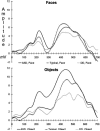ERP evidence of atypical face processing in young children with autism
- PMID: 16897400
- PMCID: PMC2989721
- DOI: 10.1007/s10803-006-0126-x
ERP evidence of atypical face processing in young children with autism
Abstract
Autism involves a basic impairment in social cognition. This study investigated early stage face processing in young children with autism by examining the face-sensitive early negative event-related brain potential component in 3-4 year old children with autism spectrum disorder (ASD), typical development, and developmental delay. Results indicated that children with ASD showed a slower electrical brain response to faces and a larger amplitude response to objects compared to children with typical development and developmental delay. These findings indicate that children with ASD have a disordered pattern of brain responses to faces and objects at an early age.
Figures



References
-
- Adrien J, Faure M, Perrot A, Hameury L, Garreau B, Barthelemy C, Sauvage D. Autism and family home movies: preliminary findings. Journal of Autism and Developmental Disorders. 1991;21(1):43–49. - PubMed
-
- Baron-Cohen S. Mindblindness, An essay on autism and theory of mind. Bradford/MIT Press; Cambridge, MA: 1995.
-
- Begleiter H, Porjesz B, Wang W. Event-related brain potentials differentiate priming and recognition to familiar and unfamiliar faces. Electroencephalography and clinical neurophysiology. 1995;94(1):41–49. - PubMed
-
- Bentin S, Deouell LY. Structural encoding and identification in face processing, ERP evidence for separate mechanisms. Cognitive Neuropsychology. 2000;17:35–54. - PubMed
-
- Bentin S, Deouell LY, Soroker N. Selective visual streaming in face recognition: evidence from developmental prosopagnosia. Neuroreport. 1999;10(4):823–827. - PubMed
Publication types
MeSH terms
Grants and funding
LinkOut - more resources
Full Text Sources

